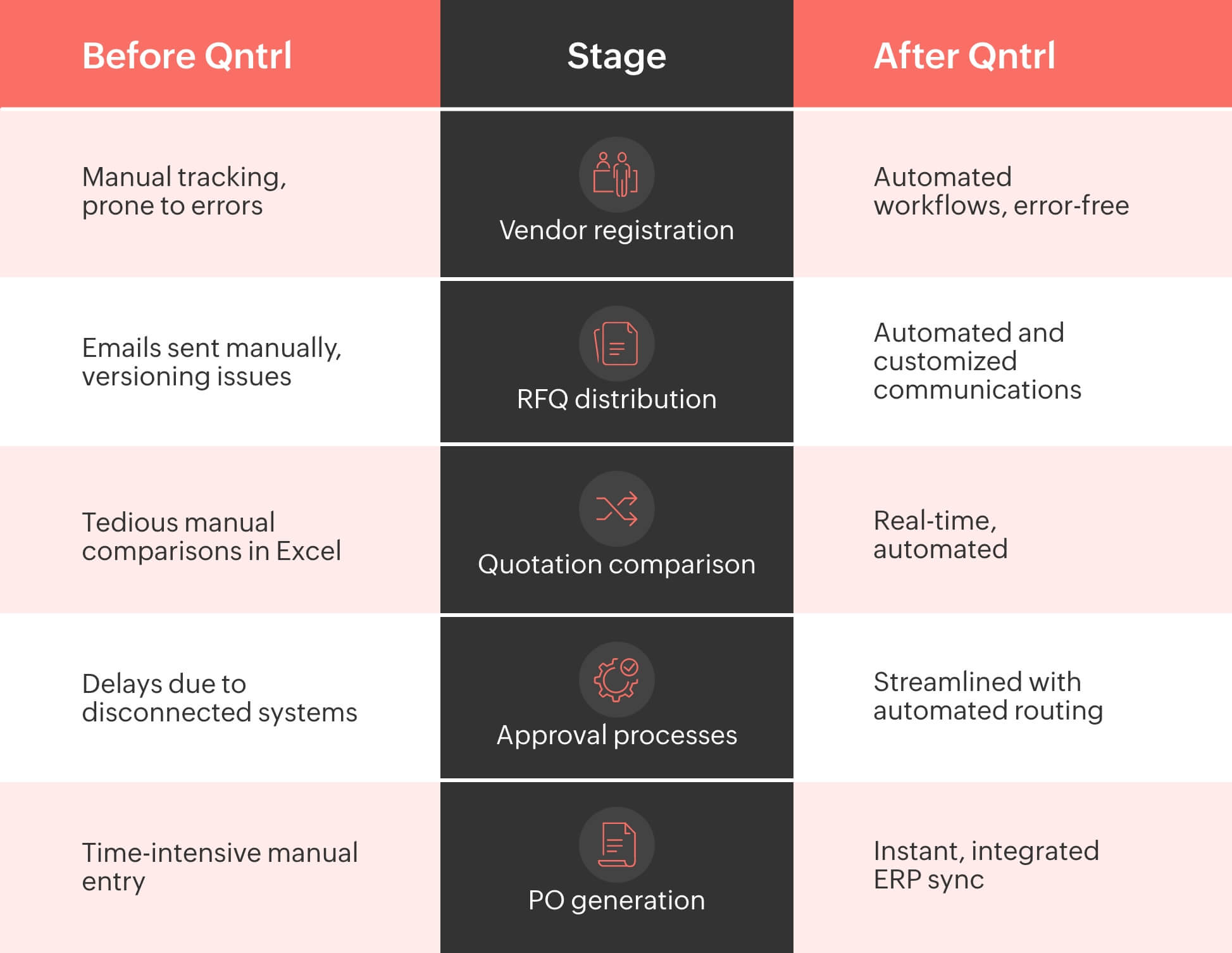Effortless RFQs to exceptional results: Reinvent your procurement process with Qntrl
- HOME
- Procurement
- Effortless RFQs to exceptional results: Reinvent your procurement process with Qntrl
The clock is ticking. As a procurement manager in a fast-growing enterprise, you’re riding the high of landing a game-changing contract—only to face the not-so-glamorous reality of vendor negotiations. Your inbox overflows with RFQ-related emails from suppliers, your team is scrambling to align vendor quotes, and your ERP system... let’s just say it’s less “efficient partner” and more “technological roadblock" to put it diplomatically!
Stakeholders? They're eager for updates—yesterday!
Sound like a scene straight out of your workday?
If this resonates, you’re not alone. Procurement teams worldwide face these challenges daily. Disjointed communication, manual vendor vetting, and data silos are just the tip of the iceberg, leaving procurement leaders frustrated and operations stuck in the slow lane. At Qntrl, we don’t just understand these challenges—we’ve lived them, analyzed them, and engineered a solution that turns RFQ headaches into seamless workflows.
In this article, we’ll explore how Qntrl redefines RFQ processes, addressing the exact pain points you face daily. Whether you're sourcing critical materials for a construction project or negotiating complex service contracts in tech, Qntrl is your partner in turning it from a routine process into a powerful driver of business growth.
What's an RFQ?
A request for quotation (RFQ) is a standardized procurement process where organizations invite suppliers to submit bids for specific goods or services.
This process typically spans:
Vendor shortlisting and registration
Drafting and sending RFQs
Receiving and analyzing bids
Vendor evaluation and selection
Approval and purchase requisition generation
However, challenges like manual inefficiencies, lack of integration between cloud and on-premises ERP systems, and poor collaboration among stakeholders make traditional RFQ processes cumbersome.
Let’s explore how Qntrl addresses the pains of traditional RFQ workflows and redefines procurement for enterprises across diverse industries.
The challenges of traditional RFQ management
For enterprise leaders like CPOs and COOs, overseeing RFQ management often feels like trying to steer a ship through turbulent waters with outdated navigation tools. Despite organizations' best efforts, the process remains riddled with inefficiencies that hinder strategic goals.
Manual vendor vetting
Sorting through piles of vendor data, cross-verifying credentials, and assessing fit takes hours—sometimes days. This tedious process delays procurement cycles and introduces human error, costing precious time and trust.
Some procurement teams focus on cost, while others prioritize delivery times or quality certifications. But this lack of standardization leads to:
Bias in vendor selection
Difficulty in justifying decisions to stakeholders
Missed opportunities to engage with suppliers offering the best overall value
Disjointed communication
Procurement teams, suppliers, and stakeholders operate in silos. Emails, missed messages, and unclear updates result in misaligned objectives, delayed decisions, and a broken feedback loop.
Poor coordination can result in:
Delays in defining technical specifications
Misalignment between budgets and procurement goals
Redundant efforts
Lack of integration
Many enterprises juggle on-premises ERPs, cloud systems, and disconnected platforms. The result? An integration nightmare where data silos prevent real-time insights and slow decision-making to a crawl.
Global sourcing also introduces complexities related to compliance with local laws and regulations. These include:
Verifying adherence to environmental, labor, and safety standards
Navigating trade restrictions, tariffs, and embargoes
Ensuring that contracts and agreements meet regional legal requirements
Vendor management at scale
Managing hundreds—or even thousands—of suppliers across geographies is a monumental task. Inconsistent processes and a lack of standardization make scaling vendor relationships a constant uphill battle.
Teams often react to RFQ requirements rather than planning proactively, resulting in:
Missed opportunities to negotiate better terms through early engagement
Increased costs due to last-minute purchases
Inability to develop long-term supplier partnerships
Data silos across RFQ stages
From initiating RFQs to evaluating bids, critical data gets trapped in disconnected systems. This lack of visibility leaves procurement leaders blind to bottlenecks, making it nearly impossible to track performance metrics or optimize the process.
Traditional RFQ processes rely on emails or spreadsheets for tracking, leading to:
Lack of real-time insights into pending approvals or responses
Delays caused by overlooked tasks or missed deadlines
Difficulty in reporting progress to senior management
Vendor risk management gaps
Risks related to vendor reliability, financial stability, and geopolitical factors are often overlooked during RFQ evaluations. This results in:
Supplier defaults on delivery commitments
Quality issues impacting downstream operations
Cost escalations from unexpected supplier risks
Difficulty in tracking procurement KPIs
Traditional RFQ workflows make it hard to measure procurement performance. Challenges include:
Inability to effectively track cycle times, cost savings, and supplier performance
Lack of insights into bottlenecks in the RFQ pipeline
Challenges in aligning procurement goals with broader organizational objectives
Effortless procurement, tailored to every industry
Procurement challenges vary across industries, but the need for efficiency, accuracy, and agility remains universal. Qntrl 3.0 is designed to address these challenges head-on, offering solutions that simplify RFQ management and streamline procurement workflows. From vendor evaluation to quote tracking, its capabilities adapt seamlessly to meet the unique demands of different sectors.
Vendor shortlisting made effortless
In the automotive sector, original equipment manufacturers (OEMs) often manage a vast network of Tier 1 and Tier 2 suppliers for components like airbags, sensors, or ECUs (electronic control units). Procurement teams must also vet suppliers for ISO certifications, compliance with IATF 16949 standards, and past delivery performance.
With Qntrl 3.0
Connected cards seamlessly integrate vendor performance dashboards with procurement workflows.
For instance, procurement managers can instantly pull details such as PPM defect rates, supplier lead times, and recent audit scores. Instead of manually cross-referencing reports or spreadsheets, the platform automatically imports vendor credentials and compliance statuses into RFQ workflows. This automation eliminates manual errors, speeds up supplier evaluation, and ensures that only vendors meeting stringent automotive standards are considered for RFQs.
Read more on digitizing the vendor management process
Streamlined RFQ distribution
In the EPC (engineering, procurement, and construction) industry, projects like metro rail expansions or high-rise developments require precise and timely procurement of materials like rebar, cement, and construction machinery. These projects involve tight schedules and high penalties for delays.
With Qntrl 3.0
Custom functions automatically generate RFQs based on project milestones or bill-of-materials (BOM) requirements.
For example, when a new phase of construction begins, Qntrl triggers an RFQ for materials like M40-grade concrete and sends it to prequalified suppliers. Vendors receive RFQs in standardized templates, prefilled with specifications like compressive strength, batch volumes, and delivery timelines.
This ensures suppliers respond with consistent, comparable data, enabling procurement teams to make quick, informed decisions. Delays in material procurement are minimized, and project timelines are safeguarded.
Real-time quote tracking and analysis
In the technology sector, companies sourcing cloud infrastructure or data center equipment often receive quotes with highly variable formats—making comparison difficult. Teams must evaluate costs, SLA (service-level agreement) terms, and compliance with industry standards like SOC 2 or ISO 27001.
With Qntrl 3.0
Standalone cards track each quote independently, allowing procurement managers to maintain focus on the specifics of each submission. For example, a procurement team evaluating bids for AWS, Azure, and Google Cloud services can individually assess pricing models (on-demand vs. reserved instances), SLA guarantees, and regional availability zones. Consolidated reporting tools then generate side-by-side comparisons of unit costs per GB, uptime guarantees, and data migration fees.
Qntrl simplifies the evaluation process, ensuring every quote is analyzed in depth while maintaining visibility into the overall RFQ progress. This empowers faster decision-making with reduced risk of oversight.
Adapting to dynamic procurement needs
In the hospitality sector, resort chains experience seasonal spikes in demand for consumables like gourmet ingredients, toiletries, or luxury bedding. Manual adjustments to procurement processes often lead to stockouts or over-ordering.
Procurement managers can dynamically tweak workflows to accommodate changing needs. For instance, the system can automatically increase RFQ frequency for premium chocolate suppliers during holiday seasons. Integration with inventory systems ensures that orders are calibrated to stock levels, avoiding overstocks or shortages.
To put this in perspective with an example, say, in government procurement, large-scale tenders for infrastructure projects require strict compliance with audit trails, approval hierarchies, and bidder confidentiality.
With Qntrl 3.0
Procurement teams can configure workflows to ensure adherence to public sector procurement policies, such as e-procurement mandates or GeM portal integrations in India. Built-in audit trails ensure traceability for every decision, reducing risks of disputes or non-compliance.
💡 Qntrl supports integration with tools like NetSuite, Microsoft Dynamics, and custom ERP systems through API connections, allowing seamless data exchange and workflow automation in accounts payable and procurement processes. These integrations can enhance efficiency, visibility, and control over workflows by centralizing data and automating routine tasks.
Seamless approvals and PO generation
In renewable energy projects, procuring specialized components like wind turbine blades or solar inverters involves multi-tiered approvals, often requiring inputs from engineering, finance, and compliance teams. A delayed PO can mean months of project delays, impacting ROI and regulatory timelines.
With Qntrl 3.0
Qntrl facilitates real-time approval workflows by centralizing data and automating approval processes within the platform. For example, after selecting a vendor for wind turbine generators, Qntrl routes the finalized quote—complete with negotiated terms on warranty periods, spare part availability, and installation support—to relevant stakeholders for digital approval. Custom notifications and escalations also ensure that any bottlenecks in the process are quickly addressed, maintaining project momentum.
This automation significantly reduces the time between quote acceptance and PO issuance, ensuring that procurement cycles align with project timelines and operational goals.
Before Qntrl vs. after Qntrl
Here's a snapshot of how inefficiencies turn into opportunities for seamless automation and smarter decisions with Qntrl:

Wrapping up
We've covered a lot of ground today, and capturing it all in a few words isn't easy, but here's the essence: Imagine a procurement process where everything just clicks—deadlines are met, data flows effortlessly, and your team works together like a well-oiled machine. That’s the reality Qntrl brings to your organization!
Qntrl takes the headaches out of RFQ management. It helps you simplify vendor evaluations, automate RFQ distribution, and track quotes in real time—all while seamlessly integrating with your ERP systems. Whether you’re navigating complex supplier networks or trying to improve procurement efficiency, Qntrl adapts to your needs, making the process faster, smarter, and stress-free.
So if you're ready to stop managing RFQs the hard way and start focusing on strategic wins, Qntrl is your answer.
Sign up now for Qntrl and take the first step toward transforming your procurement process—because smarter decisions begin with smarter tools.
Enjoying your reading?
Enjoy organization and visibility too!
Qntrl can help you organise, control and improve production and projects in your team.








Comments